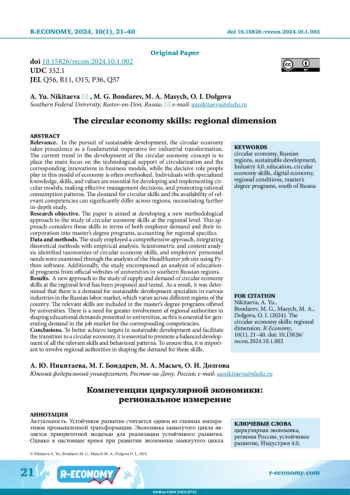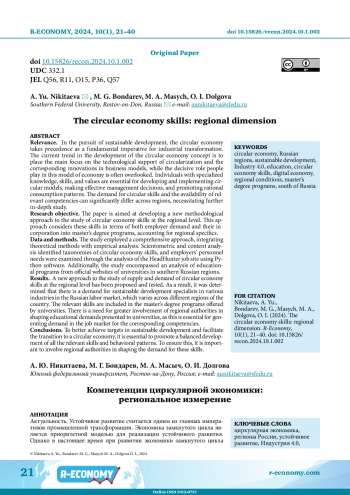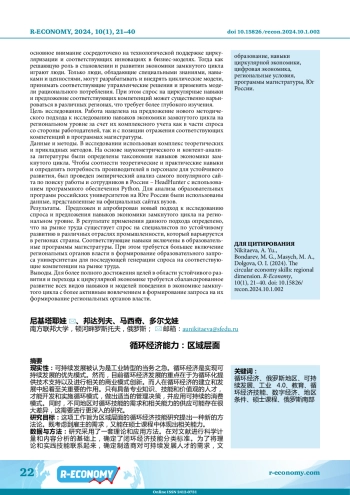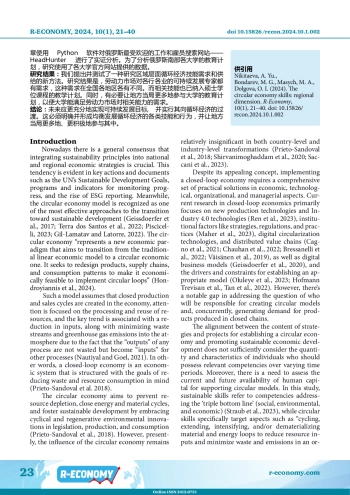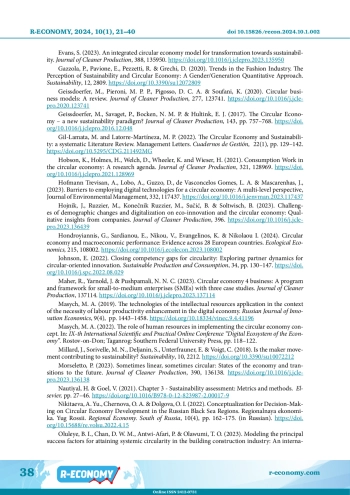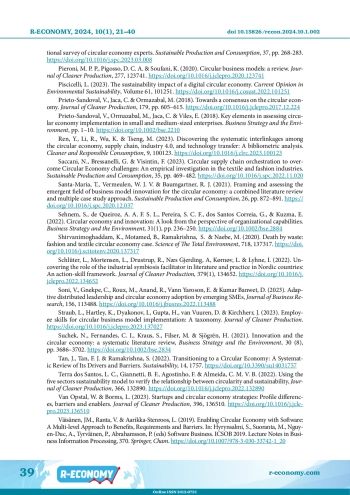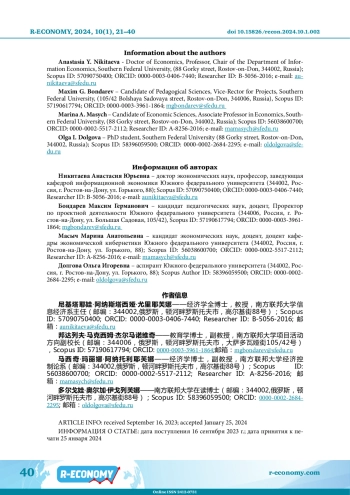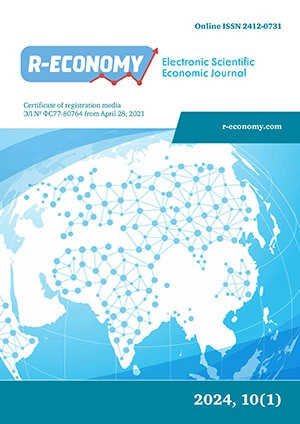Relevance. In the pursuit of sustainable development, the circular economy takes precedence as a fundamental imperative for industrial transformation. The current trend in the development of the circular economy concept is to place the main focus on the technological support of circularization and the corresponding innovations in business models, while the decisive role people play in this model of economy is often overlooked. Individuals with specialized knowledge, skills, and values are essential for developing and implementing circular models, making effective management decisions, and promoting rational consumption patterns. The demand for circular skills and the availability of relevant competencies can significantly differ across regions, necessitating further in-depth study. Research objective. The paper is aimed at developing a new methodological approach to the study of circular economy skills at the regional level. This approach considers these skills in terms of both employer demand and their incorporation into master’s degree programs, accounting for regional specifics. Data and methods. The study employed a comprehensive approach, integrating theoretical methods with empirical analysis. Scientometric and content analysis identified taxonomies of circular economy skills, and employers’ personnel needs were examined through the analysis of the HeadHunter job site using Python software. Additionally, the study encompassed an analysis of educational programs from official websites of universities in southern Russian regions. Results. A new approach to the study of supply and demand of circular economy skills at the regional level has been proposed and tested. As a result, it was determined that there is a demand for sustainable development specialists in various industries in the Russian labor market, which varies across different regions of the country. The relevant skills are included in the master’s degree programs offered by universities. There is a need for greater involvement of regional authorities in shaping educational demands presented to universities, as this is essential for generating demand in the job market for the corresponding competencies. Conclusions. To better achieve targets in sustainable development and facilitate the transition to a circular economy, it is essential to promote a balanced development of all the relevant skills and behavioral patterns. To ensure this, it is important to involve regional authorities in shaping the demand for these skills.
Идентификаторы и классификаторы
Nowadays there is a general consensus that integrating sustainability principles into national and regional economic strategies is crucial. This tendency is evident in key actions and documents such as the UN’s Sustainable Development Goals, programs and indicators for monitoring progress, and the rise of ESG reporting. Meanwhile, the circular economy model is recognized as one of the most effective approaches to the transition toward sustainable development (Geissdoerfer et al., 2017; Terra dos Santos et al., 2022; Piscicelli, 2023; Gil-Lamatav and Latorre, 2022). The circular economy “represents a new economic paradigm that aims to transition from the traditional linear economic model to a circular economic one. It seeks to redesign products, supply chains, and consumption patterns to make it economically feasible to implement circular loops” (Hondroyiannis et al., 2024).
Список литературы
1. Abashkin V., Gokhberg L., Eferin Y. et al. (2021). Gokhberg L., Kutsenko E. (eds.) Atlas of Economic Specialisation of Russian Regions, Moscow: HSE.
2. Arranz C. F. A., Arroyabe M. F. (2023). Institutional theory and circular economy business models: The case of the European Union and the role of consumption policies. Journal of Environmental Management, 117906. DOI: 10.1016/j.jenvman.2023.117906
3. Borms L., Van Opstal W., Brusselaers J., Van Passel S. (2023). The working future: An analysis of skills needed by circular startups. Journal of Cleaner Production, 409, 137261. DOI: 10.1016/j.jclepro.2023.137261 EDN: RFHDVG
4. Bressanelli G., Adrodegari F., Pigosso D. C. A. A., Parida V. (2022). Towards the smart circular economy paradigm: a definition, conceptualization, and research agenda. Sustainability, 14, 4960. DOI: 10.3390/su14094960 EDN: YMSYWK
5. Burger M., Stavropoulos S., Ramkumar S., Dufourmont J., Oort F. (2019). The heterogeneous skill-base of circular economy employment. Research Policy, 48 (1) pp. 248-261. DOI: 10.1016/j.respol.2018.08.015
6. Cagno E., Neri A., Negri M., Bassani C. A., Lampertico T. (2021). The role of digital technologies in operationalizing the circular economy transition: a systematic literature review. Applied Sciences, 11,3328. DOI: 10.3390/app11083328 EDN: LIKKMW
7. Chauhan C., Parida V., Dhir A. (2022). Linking circular economy and digitalisation technologies: a systematic literature review of past achievements and future promises. Technological Forecasting and Social Change, 177:121508. DOI: 10.1016/j.techfore.2022.121508 EDN: ZURFKU
8. Chowdhury S., Kumar Dey P., Rodríguez-Espíndola O., Parkes G., Thi Anh Tuyet N., Duc Long D., Phuong Ha T. (2022). Impact of Organisational Factors on the Circular economy Practices and Sustainable Performance of Small and Medium-sized Enterprises in Vietnam. Journal of Business Research, 147, pp. 362-378. DOI: 10.4324/9781003018551-3 EDN: JBZWYH
9. De los Rios I. C., Charnley F. J. S. (2017). Skills and capabilities for a sustainable and circular economy: The changing role of design. Journal of Cleaner Production, 160, pp. 109-122. DOI: 10.1016/j.jclepro.2016.10.130
10. Erdiaw-Kwasie M. O., Abunyewah M., Yusif S., Erdiaw-Kwasie A. (2023). Does circular economy knowledge matter in sustainable service provision? A moderation analysis. Journal of Cleaner Production, 383, 135429. DOI: 10.1016/j.jclepro.2022.135429 EDN: GRHZCT
11. Ermolaeva Yu. V. (2021). Transformation of green professions and jobs in the circular economy. Innovation and investment, 9, pp. 29-34.. DOI: 10.24412/2307-180X-2021-9-29-34 EDN: GSSJGJ
12. Evans S. (2023). An integrated circular economy model for transformation towards sustainability. Journal of Cleaner Production, 388, 135950. DOI: 10.1016/j.jclepro.2023.135950 EDN: WZJILQ
13. Gazzola P., Pavione E., Pezzetti R., Grechi D. (2020). Trends in the Fashion Industry. The Perception of Sustainability and Circular Economy: A Gender/Generation Quantitative Approach. Sustainability, 12, 2809. DOI: 10.3390/su12072809 EDN: VCUSTY
14. Geissdoerfer M., Pieroni M. P. P., Pigosso D. C. A., Soufani K. (2020). Circular business models: A review. Journal of Cleaner Production, 277, 123741. DOI: 10.1016/j.jclepro.2020.123741 EDN: IVHQSY
15. Geissdoerfer M., Savaget P., Bocken N. M. P., Hultink E. J. (2017). The Circular Economy - a new sustainability paradigm? Journal of Cleaner Production, 143, pp. 757-768. DOI: 10.1016/j.jclepro.2016.12.048
16. Gil-Lamata M., Latorre-Martíneza M. P. (2022). The Circular Economy and Sustainability: a systematic Literature Review. Management Letters. Cuadernos de Gestión, 22(1), pp. 129-142. DOI: 10.5295/CDG.211492MG EDN: NSKNHN
17. Hobson K., Holmes H., Welch D., Wheeler K., Wieser H. (2021). Consumption Work in the circular economy: A research agenda. Journal of Cleaner Production, 321, 128969. DOI: 10.1016/j.jclepro.2021.128969 EDN: HQEEIU
18. Hofmann Trevisan A., Lobo A., Guzzo D., de Vasconcelos Gomes L. A., Mascarenhas J. (2023). Barriers to employing digital technologies for a circular economy: A multi-level perspective, Journal of Environmental Management, 332, 117437. DOI: 10.1016/j.jenvman.2023.117437 EDN: ICCJUW
19. Hojnik J., Ruzzier M., Konečnik Ruzzier M., Sučić B., Soltwisch B. (2023). Challenges of demographic changes and digitalization on eco-innovation and the circular economy: Qualitative insights from companies. Journal of Cleaner Production, 396. DOI: 10.1016/j.jclepro.2023.136439
20. Hondroyiannis G., Sardianou E., Nikou V., Evangelinos K., Nikolaou I. (2024). Circular economy and macroeconomic performance: Evidence across 28 European countries. Ecological Economics, 215, 108002. DOI: 10.1016/j.ecolecon.2023.108002 EDN: YJZWKF
21. Johnson E. (2022). Closing competency gaps for circularity: Exploring partner dynamics for circular-oriented innovation. Sustainable Production and Consumption, 34, pp. 130-147. DOI: 10.1016/j.spc.2022.08.029 EDN: NGLJYI
22. Maher R., Yarnold J., Pushpamali N. N. C. (2023). Circular economy 4 business: A program and framework for small-to-medium enterprises (SMEs) with three case studies. Journal of Cleaner Production, 137114. DOI: 10.1016/j.jclepro.2023.137114
23. Masych M. A. (2019). The technologies of the intellectual resources application in the context of the necessity of labour productivity enhancement in the digital economy. Russian Journal of Innovation Economics, 9(4), pp. 1443-1458. DOI: 10.18334/vinec.9.4.41196 EDN: YTRTTG
24. Masych M. A. (2022). The role of human resources in implementing the circular economy concept. In: IX-th International Scientific and Practical Online Conference “Digital Ecosystem of the Economy”. Rostov-on-Don; Taganrog: Southern Federal University Press, pp. 118-122. EDN: QQMMSQ
25. Millard J., Sorivelle M. N., Deljanin S., Unterfrauner E., Voigt C. (2018). Is the maker movement contributing to sustainability? Sustainability, 10, 2212. DOI: 10.3390/su10072212
26. Morseletto P. (2023). Sometimes linear, sometimes circular: States of the economy and transitions to the future. Journal of Cleaner Production, 390, 136138. DOI: 10.1016/j.jclepro.2023.136138 EDN: JHGYAG
27. Nautiyal H., Goel V. (2021). Chapter 3 - Sustainability assessment: Metrics and methods. Elsevier, pp. 27-46. DOI: 10.1016/B978-0-12-823987-2.00017-9
28. Nikitaeva A. Yu., Chernova O. A., Dolgova O. I. (2022). Conceptualization for Decision-Making on Circular Economy Development in the Russian Black Sea Regions. Regionalnaya ekonomika. Yug Rossii. Regional Economy. South of Russia, 10(4), pp. 162-175. (in Russian). DOI: 10.15688/re.volsu.2022.4.15
29. Oluleye B. I., Chan D. W. M., Antwi-Afari P., Olawumi T. O. (2023). Modeling the principal success factors for attaining systemic circularity in the building construction industry: An interna tional survey of circular economy experts. Sustainable Production and Consumption, 37, pp. 268-283. DOI: 10.1016/j.spc.2023.03.008 EDN: FDYLAE
30. Pieroni M. P. P., Pigosso D. C. A., Soufani K. (2020). Circular business models: a review. Journal of Cleaner Production, 277, 123741. DOI: 10.1016/j.jclepro.2020.123741 EDN: IVHQSY
31. Piscicelli L. (2023). The sustainability impact of a digital circular economy. Current Opinion in Environmental Sustainability, Volume 61, 101251. DOI: 10.1016/j.cosust.2022.101251
32. Prieto-Sandoval V., Jaca C., Ormazabal M. (2018). Towards a consensus on the circular economy. Journal of Cleaner Production, 179, pp. 605-615. DOI: 10.1016/j.jclepro.2017.12.224
33. Prieto-Sandoval V., Ormazabal M., Jaca C., Viles E. (2018). Key elements in assessing circular economy implementation in small and medium-sized enterprises. Business Strategy and the Environment, pp. 1-10. DOI: 10.1002/bse.2210
34. Ren Y., Li R., Wu K., Tseng M. (2023). Discovering the systematic interlinkages among the circular economy, supply chain, industry 4.0, and technology transfer: A bibliometric analysis. Cleaner and Responsible Consumption, 9, 100123. DOI: 10.1016/j.clrc.2023.100123 EDN: OFRXHS
35. Saccani N., Bressanelli G., Visintin F. (2023). Circular supply chain orchestration to overcome Circular Economy challenges: An empirical investigation in the textile and fashion industries. Sustainable Production and Consumption, 35, pp. 469-482. DOI: 10.1016/j.spc.2022.11.020 EDN: VSVCEI
36. Santa-Maria T., Vermeulen W. J. V., Baumgartner R. J. (2021). Framing and assessing the emergent field of business model innovation for the circular economy: a combined literature review and multiple case study approach. Sustainable Production and Consumption, 26, pp. 872-891. DOI: 10.1016/j.spc.2020.12.037 EDN: EKDNBT
37. Sehnem S., de Queiroz A. A. F. S. L., Pereira S. C. F., dos Santos Correia G., Kuzma E. (2022). Circular economy and innovation: A look from the perspective of organizational capabilities. Business Strategy and the Environment, 31(1), pp. 236-250. DOI: 10.1002/bse.2884 EDN: IEBAQG
38. Shirvanimoghaddam K., Motamed B., Ramakrishna S., Naebe M. (2020). Death by waste: fashion and textile circular economy case. Science of The Total Environment, 718, 137317. DOI: 10.1016/j.scitotenv.2020.137317 EDN: OFUWTF
39. Schlüter L., Mortensen L., Drustrup R., Næs Gjerding A, Kørnøv L., Lyhne I. (2022). Uncovering the role of the industrial symbiosis facilitator in literature and practice in Nordic countries: An action-skill framework. Journal of Cleaner Production, 379(1), 134652. DOI: 10.1016/j.jclepro.2022.134652 EDN: KGTVFR
40. Soni V., Gnekpe C., Roux M., Anand R., Vann Yaroson E., Kumar Banwet D. (2023). Adaptive distributed leadership and circular economy adoption by emerging SMEs, Journal of Business Research, 156, 113488. DOI: 10.1016/j.jbusres.2022.113488 EDN: QPXHHZ
41. Straub L., Hartley K., Dyakonov I., Gupta H., van Vuuren D., Kirchherr J. (2023). Employee skills for circular business model implementation: A taxonomy. Journal of Cleaner Production. DOI: 10.1016/j.jclepro.2023.137027
42. Suchek N., Fernandes C. I., Kraus S., Filser M., Sjögrén H. (2021). Innovation and the circular economy: a systematic literature review, Business Strategy and the Environment, 30 (8), pp. 3686-3702. DOI: 10.1002/bse.2834 EDN: TFPCOM
43. Tan J., Tan F. J., Ramakrishna S. (2022). Transitioning to a Circular Economy: A Systematic Review of Its Drivers and Barriers. Sustainability, 14, 1757. DOI: 10.3390/su14031757 EDN: LKPQRO
44. Terra dos Santos L. C., Giannetti B. F., Agostinho F., Almeida C. M. V. B. (2022). Using the five sectors sustainability model to verify the relationship between circularity and sustainability, Journal of Cleaner Production, 366, 132890. DOI: 10.1016/j.jclepro.2022.132890 EDN: QUAOHE
45. Van Opstal W., Borms L. (2023). Startups and circular economy strategies: Profile differences, barriers and enablers. Journal of Cleaner Production, 396, 136510. DOI: 10.1016/j.jclepro.2023.136510 EDN: IOXMEM
46. Väisänen J. M., Ranta V., Aarikka-Stenroos L. (2019). Enabling Circular Economy with Software: A Multi-level Approach to Benefits, Requirements and Barriers. In: Hyrynsalmi, S., Suoranta, M., Nguyen-Duc, A., Tyrväinen, P., Abrahamsson, P. (eds) Software Business. ICSOB 2019. Lecture Notes in Business Information Processing, 370. Springer, Cham. DOI: 10.1007/978-3-030-33742-1_20
Выпуск
Другие статьи выпуска
Relevance. In Central Asia, growing economic and infrastructural challenges require urgent solutions and a shift from resource-dependent economies. Although each Central Asian country is following its own independent path, regional integration processes are crucial for enhancing competitiveness at both individual and regional levels. Research Objective. The study aims to conduct a comparative analysis of the competitiveness of Central Asian economies, identifying both their weaknesses and opportunities for sustainable development in the region. Data and Methods. The study relies on both secondary qualitative and quantitative data, drawing on international research on competitiveness and methodological provisions developed by the World Economic Forum. Identical indicators from the World Bank database are analyzed for an indirect assessment of the global competitiveness of Central Asian economies. Results. The study’s findings reveal varying levels of competitiveness among the economies in question. Kazakhstan and Uzbekistan, in particular, have shown progress in this sphere due to the availability of natural resources, economic reforms, investments in infrastructure, and the development of human capital. Conclusions. In order to improve the quality of life for their citizens, Central Asian countries need to enhance their competitiveness, which can be accomplished by implementing measures such as diversifying economies, strengthening institutions, and attracting investment in innovative projects.
Relevance. Strengthening fiscal decentralization is viewed as a crucial strategy to foster the economic development of Russian regions. Research Objective. The research aims to assess the potential impact of redistributing tax revenues, particularly VAT, among various budget levels. Data and Methods. The study employs regression analysis to investigate the correlation between the Gross Regional Product (GRP) of Russian regions and the expenditures of their consolidated budgets. A comparative analysis is also conducted, using data from the Federal Tax Service on VAT receipts to the federal budget and data from the Federal State Statistics Service on GRP and expenditure components of regional budgets from 2005 to 2021. Results. The research confirms the Russian government’s concerns regarding a possible increase in economic disparities if 40% of VAT is shifted to sub-federal levels. It reveals the negative impact that such a measure would have on specific regions. Instead, a more promising approach is to implement a special budgetary regime in select regions to stimulate their development. Conclusions. The study showcases adverse effects associated with transferring 40% of VAT to the sub-federal level. It proposes a mechanism to enhance fiscal decentralization in Russia, aiming to advance regional economic development, address economic disparities among regions, and offset any potential reduction in federal budget revenues.
Relevance. The unprecedented disruptions caused by the COVID-19 pandemic had a profound impact on the global economy, including Indonesia. Despite the challenges, Indonesia successfully managed to navigate and recover its international economic activities. Analyzing how Indonesia navigated its export advantages during the COVID-19 pandemic is crucial for understanding its resilience in the global economy. Research objective. The study aims to analyze the comparative and competitiveness of Indonesian export products, particularly the food processing industry, under the scheme of emerging markets and developing economies during the COVID-19 pandemic. Data and methods. This study relies on the data from Badan Pusat Statistik (BPS) and the Indonesian Ministry of Trade, along with world export data from the World Bank, OECD, and the International Trade Center, to examine the food processing industry during the 2021-2022 pandemic. Using the Revealed Comparative Advantage (RCA) model, it classifies comparative products for potential exports and diversification guidance. The Export Product Dynamics (EPD) model measures competitive advantage and serves as an early warning indicator, providing a comprehensive trade analysis for identifying growth opportunities and mitigating risks. Results. The RCA findings indicate that Indonesian processed food products for emerging market countries exhibit strong comparatives, supported by factors such as selling prices, production capacity, innovative technology, and trade tariff policies. This is reinforced by the results of the EPD analysis, which shows the dominance or rising star status of these products. Conclusions. The dominance of processed Indonesian food products points to the need for the government to uphold and expand exports beyond emerging market countries. Recommended measures include initiating revitalization, transformation, market analysis, and evaluating products categorized as falling stars or experiencing failures, missed opportunities, and retreats. Additionally, a focus on the upstream-downstream sectors of the food processing industry is crucial.
Relevance. Electronic commerce (e-commerce) and social commerce (s-commerce) are transforming business and consumer behaviour in Southeast Asia, propelled by digital advancements and increased internet and smartphone usage. This trend is significantly influencing economic growth and market dynamics in these emerging economies. Research Objective. This study aims to perform a comparative analysis of e-commerce and s-commerce across Southeast Asian countries. Additionally, it seeks to explore the evolution from e-commerce to s-commerce in emerging economies, examining the opportunities and challenges embedded in this transition, and discussing the implications for businesses and consumers alike. Data and Methods. To achieve these objectives, we used a quantitative approach, surveying 872 Thai participants through an online questionnaire using a convenience sampling technique. Additionally, we analyzed the data comparing e-commerce and s-commerce across Southeast Asian countries using the documentary method and content analysis. Results. Consumer spending through e-commerce and s-commerce has a significant positive impact on economic growth in Thailand, surpassing the impact of government spending. Private consumption, a substantial component of Thailand’s GDP, stimulates production, investment, and job creation, fostering overall economic advancement. In Southeast Asia, distinct e-commerce trends are evident: Thailand benefits from high internet and smartphone usage, Indonesia from robust social media engagement, and Vietnam from a focus on social commerce and mobile, cross-border e-commerce. These diverse trends underscore the necessity for businesses to tailor their strategies to each country’s unique consumer behaviors and preferences. Conclusions. The study confirms the significant impact of electronic consumption through e-commerce and social media on GDP growth. This form of consumption not only drives demand but also creates jobs, enhances efficiency, and opens up opportunities for international trade, fostering sustained economic development. In light of these findings, governments are advised to bolster digital infrastructure and support businesses in their digital transition. Meanwhile, businesses are recommended to adapt to digital models, emphasize consumer engagement, expand globally through online platforms, and integrate sustainable practices. Collectively, these measures are designed to harness the full potential of electronic consumption for sustainable and robust economic growth.
Relevance. The adoption of new technologies and the rapid emergence of innovation spur high-tech production and export-led economic growth. We aim to provide fresh evidence on the determinants of high-tech exports, considering different macroeconomic factors within the framework of the gravity model. Research Objective. The aim of the research is to empirically assess the impact of macroeconomic instability, tax policies, natural resources endowment, human capital, and institutional environment on the promotion of high-tech exports. Data and Methods. In considering the institutional indicator, six distinct indices from the World Bank are examined, and a common indicator is computed using principal component analysis. The econometric modeling uses a panel dataset covering the world’s 80 largest economies from 1996 to 2019. To test the assumptions of the gravity model and tackle the heteroscedasticity problem, the Poisson Pseudo Maximum Likelihood methodology is employed. Results. Higher inflation and unemployment rates are found to significantly decrease high-tech exports, while government external debt contributes to their enhancement. Tight tax policy and an increase in tax contribution are counterproductive in spurring high-tech exports. A negative and significant result is found for resource endowment, indicating that an increase in resource exports is counterproductive for technological advances and high-tech production. In most cases, the institutional environment and human capital significantly promote high-tech exports. Conclusions. Based on the presented empirical findings, we offer recommendations for the government to stimulate high-tech exports.
Relevance. The development and implementation of advanced production technologies are the most important factors of economic growth and competitiveness in the modern economy. Predicting their dynamics, taking into account the spatial features of localization, is a difficult and time-consuming task. The spatial effects resulting from the impact of the surrounding territories play a significant role in the dynamics of advanced production technologies in the regions of Russia. Accounting for these effects is necessary when constructing scenario models in conditions of strong spatial heterogeneity of the studied processes. Traditional forecasting methods do not take into account spatial interdependencies and are not able to reflect the influence of surrounding regions on the development of technologies. Research objective. Assessment and scenario forecasting of the dynamics of advanced production technologies being developed in the regions of Russia using SAR models that allow taking into account spatial effects between regions. Data and methods. For scenario forecasting of the dynamics of advanced production technologies being developed in the Russian regions, taking into account spatial effects, a methodological approach was developed based on the modeling of the spatial log (SAR) of the processes of their development, autoregressive (ARMA) modeling and forecasting of the key factors of their dynamics. Taking into account spatial effects and heterogeneity, the proposed approach to modeling makes it possible to more accurately predict the dynamics of advanced production technologies in the Russian regions. Results. The developed methodological approach was tested to form predictive scenarios for the dynamics of advanced production technologies being developed in the regions of Russia. In particular, an inertial forecast scenario was developed, assuming the preservation of current trends in the dynamics of the technologies being developed, as well as two extreme possible scenarios - optimistic and pessimistic. With the help of the spatial SAR model, a significant influence of the number of research organizations on the volume of advanced production technologies generated was confirmed, and in the second group of regions, the influence of the number of technicians who conduct research and development was confirmed. The novelty of the study is to take into account the spatial features of the localization of the advanced production technologies being developed, as well as the spatial effects resulting from the impact of the surrounding regions on the creation of new technologies. This approach makes it possible to significantly reduce errors in the formation of forecast scenarios in conditions of significant spatial heterogeneity of the initial data. Conclusions. To intensify the generation of new technologies in the regions of the second group, it is necessary to attract personnel with technical specialties. The dynamics of the technologies being developed in the first group of regions with a powerful research potential are also influenced by the number of research personnel and the amount of attracted financial resources for fundamental and applied research. To increase the activity of these regions in the development of advanced technologies, it is necessary to form and develop relationships with the surrounding regions.
Статистика статьи
Статистика просмотров за 2025 год.
Издательство
- Издательство
- УрФУ
- Регион
- Россия, Екатеринбург
- Почтовый адрес
- 620002, Свердловская область, г. Екатеринбург, ул. Мира, д. 19
- Юр. адрес
- 620002, Свердловская область, г. Екатеринбург, ул. Мира, д. 19
- ФИО
- Кокшаров Виктор Анатольевич (Ректор)
- E-mail адрес
- rector@urfu.ru
- Контактный телефон
- +7 (343) 3754507
- Сайт
- https://urfu.ru/ru
